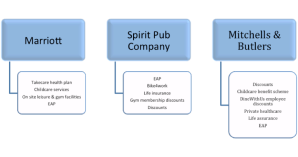Whilst stuck in the train station today I found myself wondering why isn’t wellbeing common across business. So like usual I’ve used my blog to rant and pour my own meandering thoughts out on the page.
Many organisations proclaim that “our people are at the heart of everything we do and if it wasn’t for our people we wouldn’t have a business” Sounds great, doesn’t it? but I ask you when you hear these words, look closer. What you will likely find is one or two key strategies (usually linked to training, pay) that are heavily invested by the company that gives the business the confidence to make the statements. Of course, companies should train their people better and pay them more, yet for me these are the basics of being a ‘good business’ and unfortunately, we humans are much more complex than this.
Human beings are creators and explorers, they aim to discover, build, innovate, and change the world around them. Therefore, the quality of work life, the single biggest part of our waking adult lives, must surely count heavily for the quality of life. Can we truly say that the more training we receive and the more money I earn will ultimately make me the best employee in the world and fulfil my personal, professional and spiritual needs? if only, however sadly not. It baffles me to think that most businesses seem to forget that their employees are human, which shows through weak wellbeing programmes of work.
Businesses need to remember that the internal processes of an employee interact with job characteristics and subsequently wellbeing at work, these can’t be approached separately. Wellbeing is impacted by genetics, mood and emotional state, these along with age are likely to play a part in workplace wellbeing. It’s amazing to think that job satisfaction is typically highest amongst the oldest and youngest employees, declining in the middle years, before rising again with age. That’s me screwed then, I’m well and truly in the middle years, great!
What about the employee’s personality? Each of the ‘big five’ dimensions of personality (neuroticism, extraversion, openness to experience, agreeableness and conscientiousness) have been shown to correlate with job satisfaction, even research into the relationship between wellbeing and education has pointed to lower wellbeing among more educated workers!! Isn’t that amazing, the smarter you are, the more likely your wellbeing will suffer. That’s a great advertising campaign for university “STAY AWAY YOU’LL BE HAPPIER”
The work place factors that impact wellbeing and subsequently performance are not, unfortunately, a clear-cut list companies can chronologically follow and subsequently set policies against. Nevertheless, this has not stopped many differing companies deploying wellbeing strategies (Google, John Lewis, Safeway, Network Rail and Royal Mail). These companies understand the many benefits of having a good level of wellbeing within the workforce. Individuals with higher wellbeing have healthier diets, are more likely to exercise and less likely to smoke, experience more positive social relationships and greater levels of collaboration and cooperation within the workplace, have better cognitive processes such as creativity, problem solving, process complex information more speedily and have a wider span of attention. This, along with research suggesting that employees with lower wellbeing are less likely still to be in the same job 15 months later, make wellbeing an attractive proposition for both employer and employees. A recent study of 8,000 business units in 36 companies found that higher levels of wellbeing were associated with higher productivity and profits. Likewise, after studying 42 manufacturing companies, overall job satisfaction was positively correlated with company productivity in the subsequent year.
So, I ask you, after reading my rant, when you come across “business speak” towards employees being at the heart of the business, look closer, you’ll likely see a couple of chinks in the paint work.
Work for those companies that genuinely care for their employees, how can you tell if they do? a good place to start is by seeing what their wellbeing programme looks like and how they resonate with the employees.
P.s I don’t know why the text is all over the place……

 I also love Google’s wellness strap-line:
I also love Google’s wellness strap-line:







